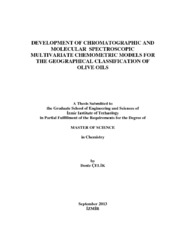Please use this identifier to cite or link to this item:
https://hdl.handle.net/11147/3654Full metadata record
| DC Field | Value | Language |
|---|---|---|
| dc.contributor.advisor | Özdemir, Durmuş | en |
| dc.contributor.author | Çelik, Deniz | - |
| dc.date.accessioned | 2014-07-22T13:52:03Z | |
| dc.date.available | 2014-07-22T13:52:03Z | |
| dc.date.issued | 2013 | en |
| dc.identifier.uri | http://hdl.handle.net/11147/3654 | |
| dc.description | Thesis (Master)--İzmir Institute of Technology, Chemistry, İzmir, 2013 | en |
| dc.description | Includes bibliographical references (leaves: 108-111) | en |
| dc.description | Text in English; Abstract: Turkish and English | en |
| dc.description | xii, 111 leaves | en |
| dc.description.abstract | Olive oil is a fat obtained from the olive (the fruit of Olea europaea; family Oleaceae), a traditional tree crop of the Mediterranean Basin. The oil is produced by grinding whole olives and extracting the oil by mechanical or chemical means. It is commonly used in cooking, cosmetics, pharmaceuticals, and soaps and as a fuel for traditional oil lamps. The classification of olive based on geographical origin is of great interest since the quality of olive oil depends on its chemical composition and geographical origin. In this study, it is aimed to develop classification models using elemental and molecular composition of olive oil samples via chromatographic method and molecular spectrometry. For this purpose, olive oil samples from diffirent regions of Turkey (Manisa and Bursa) were collected from producers and they were scanned with Fourier Transform Infrared spectrometer equiped with attenuated total reflectance (FTIR-ATR) accesory, and Gas Chromatography (GC), High Performance Liquid Chromatography (HPLC). Afterwards, any clustering of samples based on their regions was investigated using principal component analysis (PCA) and hierarchical cluster analysis (HCA). In conclusion, although molecular spectrometry is more advantageous for the classification of olive oil samples in the case of saving time, saving chemicals and ease of usage, chromatography gave better classification results based on geograpical origin compared to results obtained with molecular spectrometry. | en |
| dc.language.iso | en | en_US |
| dc.publisher | İzmir Institute of Technology | en |
| dc.publisher | Izmir Institute of Technology | en_US |
| dc.rights | info:eu-repo/semantics/openAccess | en_US |
| dc.subject.lcsh | Olive oil--Analysis | en |
| dc.title | Development of chromatographic and moleculer spetroscopic multivariate chemometric models for the geographical classification of olive oils | en_US |
| dc.type | Master Thesis | en_US |
| dc.institutionauthor | Çelik, Deniz | - |
| dc.department | Thesis (Master)--İzmir Institute of Technology, Chemistry | en_US |
| dc.relation.publicationcategory | Tez | en_US |
| item.languageiso639-1 | en | - |
| item.fulltext | With Fulltext | - |
| item.openairecristype | http://purl.org/coar/resource_type/c_18cf | - |
| item.openairetype | Master Thesis | - |
| item.grantfulltext | open | - |
| item.cerifentitytype | Publications | - |
| Appears in Collections: | Master Degree / Yüksek Lisans Tezleri | |
Files in This Item:
| File | Description | Size | Format | |
|---|---|---|---|---|
| T001182.pdf | MasterThesis | 1.41 MB | Adobe PDF |  View/Open |
CORE Recommender
Page view(s)
66
checked on Jul 22, 2024
Download(s)
42
checked on Jul 22, 2024
Google ScholarTM
Check
Items in GCRIS Repository are protected by copyright, with all rights reserved, unless otherwise indicated.